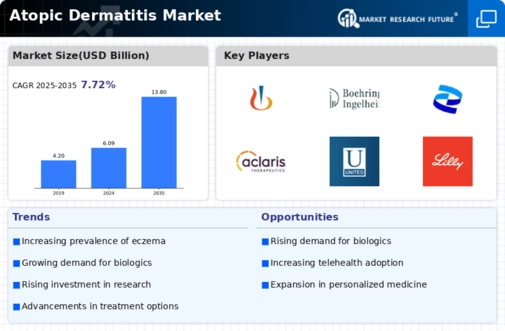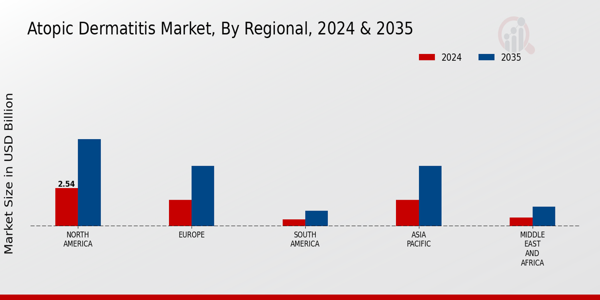Market Growth Projections
The Global Atopic Dermatitis Market Industry is projected to experience substantial growth over the next decade. With a market value of 6.09 USD Billion in 2024, it is expected to reach 13.8 USD Billion by 2035, reflecting a robust compound annual growth rate of 7.72% from 2025 to 2035. This growth trajectory indicates a strong demand for innovative treatments and management strategies for atopic dermatitis. Factors such as rising prevalence, advancements in therapies, and increased awareness are likely to contribute to this upward trend, positioning the market for continued expansion in the years to come.
Regulatory Support and Approvals
Regulatory support and timely approvals for new therapies are essential components influencing the Global Atopic Dermatitis Market Industry. Regulatory agencies are increasingly recognizing the need for effective treatments, leading to expedited review processes for promising therapies. This supportive environment encourages pharmaceutical companies to invest in developing new products, which could enhance treatment options for patients. As more therapies receive approval, the market is likely to expand, meeting the growing demand for effective management of atopic dermatitis. The evolving regulatory landscape may play a pivotal role in shaping the future of the market.
Advancements in Treatment Options
Innovations in the treatment landscape for atopic dermatitis are significantly influencing the Global Atopic Dermatitis Market Industry. The introduction of biologics and targeted therapies has transformed management strategies, offering patients more effective options. For instance, medications such as dupilumab have shown promising results in clinical trials, leading to increased adoption among healthcare professionals. As these advanced therapies become more widely available, they are expected to drive market growth. The anticipated market size of 13.8 USD Billion by 2035 reflects the potential impact of these advancements on patient care and overall market dynamics.
Increased Awareness and Education
Heightened awareness and education regarding atopic dermatitis are pivotal in shaping the Global Atopic Dermatitis Market Industry. Campaigns aimed at educating both healthcare providers and patients about the condition are likely to lead to earlier diagnosis and treatment. This increased understanding may also reduce stigma associated with the disease, encouraging individuals to seek help. As a result, the demand for treatment options is expected to rise, contributing to market growth. The projected compound annual growth rate of 7.72% from 2025 to 2035 indicates the long-term potential of this driver in enhancing market dynamics.
Rising Prevalence of Atopic Dermatitis
The Global Atopic Dermatitis Market Industry is experiencing growth driven by the increasing prevalence of atopic dermatitis worldwide. Recent data indicates that approximately 15-20 percent of children and 1-3 percent of adults are affected by this chronic skin condition. This rising incidence is likely to propel demand for effective treatments and management options, thereby expanding the market. As awareness of the condition grows, healthcare providers are more frequently diagnosing and treating atopic dermatitis, which could further contribute to market expansion. The projected market value of 6.09 USD Billion in 2024 underscores the urgency for innovative solutions in this sector.
Growing Investment in Research and Development
Investment in research and development within the Global Atopic Dermatitis Market Industry is crucial for fostering innovation and improving treatment options. Pharmaceutical companies are increasingly allocating resources to develop new therapies, driven by the unmet needs of patients. This focus on R&D is likely to yield novel treatments that address various aspects of atopic dermatitis, including its underlying causes. As new products enter the market, competition will intensify, potentially leading to better outcomes for patients. The ongoing commitment to R&D may further solidify the market's growth trajectory in the coming years.























Leave a Comment